-

-
Courses
Find courses by:
Collections
Cross-Disciplinary Topic Lists
- About
- Donate
- Featured Sites
This is an archived course. A more recent version may be available at ocw.mit.edu.
Each character entry below contains a ≤1 MB QuickTime movie of the character being painted with a brush, created by Prof. Saeko Komori of Chubu University. Please see the JP Net Kanji Project for more details.
In the following definitions, on (Chinese-based) readings are represented by katakana, and by capital romaji letters; kun (native Japanese-based) readings are represented by hiragana, and by lower-case romaji letters. This is a common dictionary convention, and does not have any bearing on meaning.

Stroke order: (MOV)
Printed form: 分
Readings:
わ(かります) wa(karimasu) - understand
フン、-プン (hun, -pun) - unit of time/arc
Mnemonic:
The number eight 八 and a sword 刀 to represent the meaning of "to divide". When you understand, it means that you can see the difference between one and the other.
Usage examples:
分かります (わかります) (I) understand.
一分 (いっぷん) one minute
五分 (ごふん) five minutes

Stroke order: (MOV)
Printed form: 行
Readings: い(きます) i(kimasu)
Meaning: to go
Mnemonic:
Two persons イ go together.
Usage examples:
行きます (いきます) (I) will go.
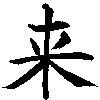
Stroke order: (MOV)
Printed form: 来
Readings: き-/く- ki-/ku-
Meaning: to come
Mnemonic:
The coming of rice grains 米 is a gift from heaven. The top line emphasizes the yield.
Usage examples:
来ません (きません) (I) won't come.
来る (くる) to come
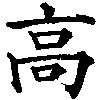
Stroke order: (MOV)
Printed form: 高
Readings: たか- taka-
Meaning: expensive; high
Mnemonic:
An image of a two-story house.
Usage examples:
高いです (たかいです) (It) is expensive.
高田さん (たかださん) (Mr.) Takada
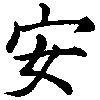
Stroke order: (MOV)
Printed form: 安
Readings: やす- yasu-
Meaning: cheap; peaceful
Mnemonic:
A woman 女 under a roof 宀 (as in 家 "house", 室 "room", 院 "institute"). She is the one who generates "peace" in the house.
Usage examples:
安いです (やすいです) (It) is cheap.
安田さん (やすださん) (Mr.) Yasuda
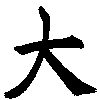
Stroke order: (MOV)
Printed form: 大
Readings: おお- oo-
Meaning: big
Mnemonic:
An image of a person with arms stretching wide - a big, strong person.
Usage examples:
大きいです (おおきいです) (It) is big.
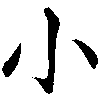
Stroke order: (MOV)
Printed form: 小
Readings: ちい- (chii-) small
こ- (ko-) small (prefix)
Mnemonic:
An image of a person with arms hanging down - a small, weak person.
Usage examples:
小さいです (ちいさいです) (It) is small.
小山さん (こやまさん) (Mr.) Koyama

Stroke order: (MOV)
Printed form: 田
Readings: た (-だ) ta (-da)
Meaning: rice field
Mnemonic:
Rice fields in Japan are square and divided by narrow paths.
Usage examples:
大田さん (おおたさん) (Mr.) Oota
小田さん (おださん) (Mr.) Oda
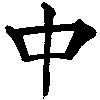
Stroke order: (MOV)
Printed form: 中
Readings: なか (naka) middle; inside
チュウ (tyuu) middle; China
Mnemonic:
An arrow striking through the middle of something.
Usage examples:
田中さん (たなかさん) (Mr.) Tanaka
中田さん (なかたさん) (Mr.) Nakada/Nakata
中山さん (なかやまさん) (Mr.) Nakayama
中ごく (ちゅうごく) China

Stroke order: (MOV)
Printed form: 日
Readings: ニチ NICHI
Meaning: day; sun
Mnemonic:
An image of the sun.
Usage examples:
日本 (にほん) Japan

Stroke order: (MOV)
Printed form: 本
Readings: ホン (ボン/ポン)/もと HON (PON/BON)/moto
Meaning: origin; book; (classifier of long objects)
Mnemonic:
A tree 木 and a short stroke at the buttom representing roots. A book is a source of knowledge.
Usage examples:
本 (ほん) book
一本 (いっぽん) one (long object)
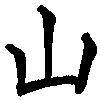
Stroke order: (MOV)
Printed form: 山
Readings: やま yama
Meaning: mountain (See also Grammar 15A Photographic Vocabulary Aid)
Mnemonic:
Shape of a mountain with three summits.
Usage examples:
山田さん (やまださん) (Mr.) Yamada
山本さん (やまもとさん) (Mr.) Yamamoto
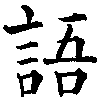
Stroke order: (MOV)
Printed form: 語
Readings: ゴ GO
Meaning: language
Mnemonic:
The combination of 言 "to say", 五 "five", and 口 "mouth", symbolizing "many tongues".
Usage examples:
日本語(にほんご) Japanese (language)
ドイツ語 (ドイツご) German (language)
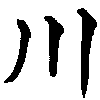
Stroke order: (MOV)
Printed form: 川
Readings: かわ kawa
Meaning: river
Mnemonic:
The course of a river.
Usage examples:
大川さん(おおかわさん) (Mr.) Ookawa
小川さん(おがわさん) (Mr.) Ogawa
川本さん(かわもとさん) (Mr.) Kawamoto
[Quizzes (JavaScript required): Meaning (15 questions) | Reading (18 questions) | Character Recognition (10 questions)]